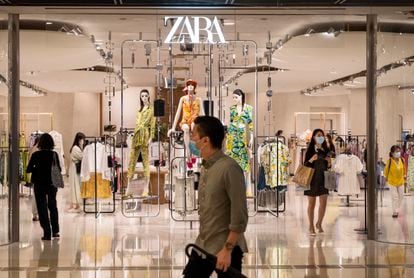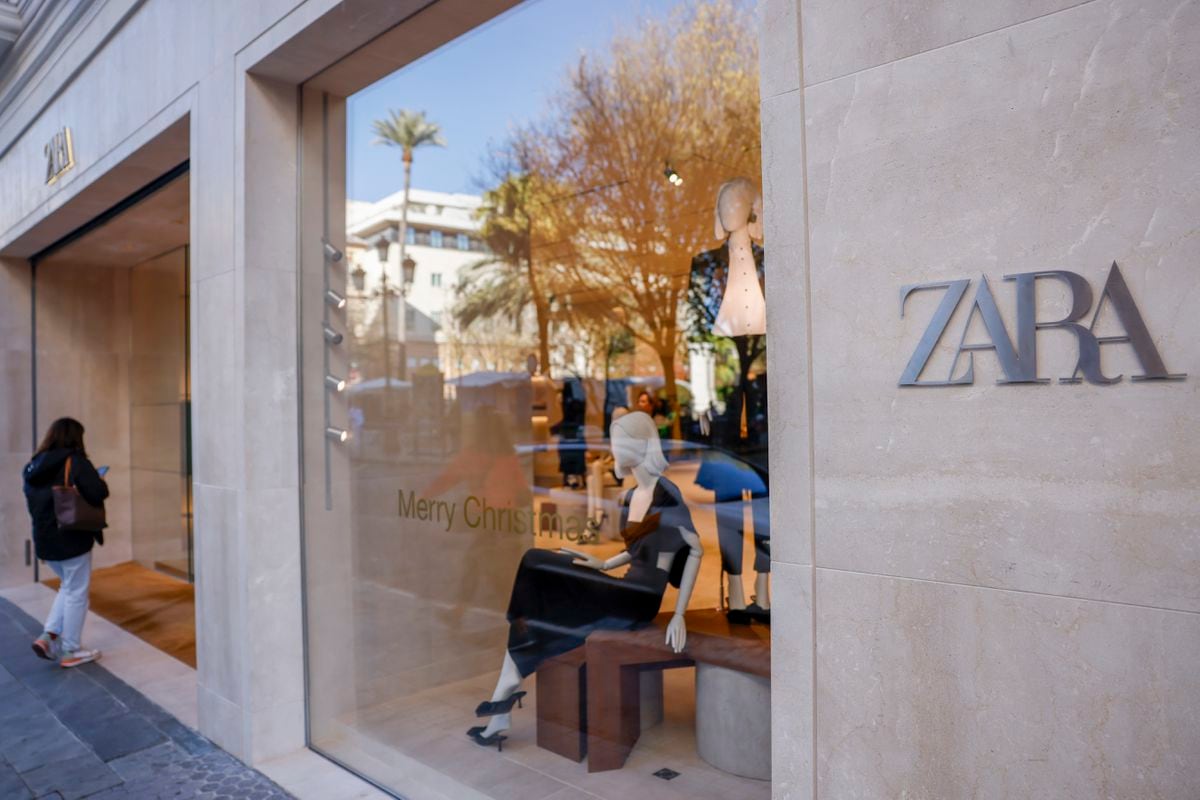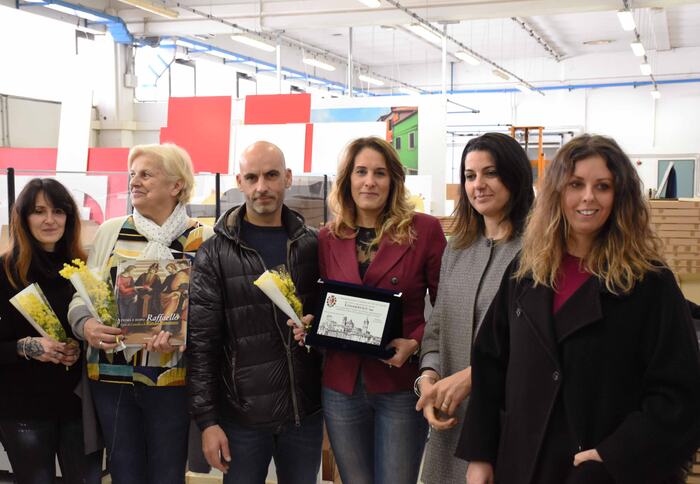The excavators work piecework at the Inditex headquarters in Arteixo (A Coruña).
The group is starting to build a huge 170,000-square-meter building that will be the base for Zara's commercial and design teams, with an investment of 238 million euros.
It will be the umpteenth expansion of the facilities since Confecciones Goa (the inverted acronym for Amancio Ortega Gaona) arrived at the Sabón industrial estate in Arteixo, 15 minutes from A Coruña, in 1977.
The architecture of the different extensions tells the story of an expanding group, from the modest original factories and the logistics building, with its industrial air, to the ultra-modern, technological, sustainable and bright headquarters of Zara.com, with wide spaces and diaphanous plants.
The Inditex headquarters has recovered its pre-pandemic bustle.
Designers, stylists, photographers, make-up artists, models, pattern makers, cutters, seamstresses, sales people, administrative staff, programmers... they work at full speed.
However, a red light shone last week on the screens in the operations room of the Inditex data processing center, the impressive technological heart of the company, in one of the rooms with the most limited access.
That red light, on a huge digital world map, listed closed Zara stores in Russia, Ukraine, and Belarus.
The red light is still on and it is the main alarm signal (but not the only one) that Marta Ortega will encounter this coming April 1 when she assumes the presidency of Inditex, the company founded by her father, Amancio Ortega, who this Monday turns 86 years old.
On November 30, by surprise and a few weeks ahead of the initially planned plan, Inditex announced the departure of Pablo Isla and his replacement by Marta Ortega, 38, as president and by Óscar García Maceiras, who was secretary of the board. for eight months, as chief executive with the position of CEO.
So, everything seemed on track for a calm and smooth transition.
“Why are we addressing this transition now?
Because we understand that it is an optimal time to address it.
Because the company is very solid, it has a well-defined strategy, it has fantastic teams in all areas, with a great combination of youth and experience”, Pablo Isla explained at the telematic press conference that day.
Isla had reasons to consider the moment optimal.
Inditex had just accumulated two quarters of record billing and profits.
The restrictions of the pandemic seemed to be left behind and the company's machinery was perfectly oiled.
“Almost all our stores are now open and
online sales
it continues with a strong rate of growth”, Isla would say two weeks later to analysts when presenting the results for the third quarter and the sales preview for the fourth quarter.
At that time, sales were growing at rates greater than 30%, or 10%, if compared to the same period in 2019, before the pandemic.
In the conference with analysts, Isla explained how the company had successfully handled the problems in the supply chain that had affected other competitors in the fashion sector, assured that the company maintained a stable price policy and no one had yet asked about Russia or Ukraine.
The threats, however, were already there.
That same November 30 in which the changeover was announced, EL PAÍS opened its print edition with this headline: "The WHO and the G-7 warn of the 'high risk' of the omicron variant."
In the pages of Internacional, still discreetly and only as a hypothesis, the word “war” appeared in reference to Ukraine and those of Economy reported that inflation was setting its record in 30 years.
Ómicron spoiled the results of the fourth quarter of its exercise, as the company itself has recognized.
Sales from November to January, the busiest period of the year, which were on track for a record, were 11% below those of 2019 and did not even match those of 2018 or 2017. The sudden decline left a bill of 400 million in results, since more aggressive reductions were necessary and the incremental expenses of the Christmas campaign and those derived from greater
online
activity had to be faced .
Pablo Isla has not been able to say goodbye with record sales and profits despite the fact that from 2004, the year before his arrival, until 2021, Inditex has quintupled its turnover and its results.
According to the company, after the drop in omicron cases and the end of most restrictions, the start of this year's spring/summer campaign had regained full force.
The pandemic is not completely over, and the confinements and closures in China in particular will continue to upset Inditex managers.
However, that is nothing compared to the impact that the closure of stores and
online
sales will have in Russia and Ukraine, which has become the most serious problem with which the era of Marta Ortega and Óscar García Maceiras begins. .
Óscar Rodríguez Maceiras (left) together with Pablo Isla, at the Inditex results presentation on March 16.
OSCAR CORRAL (THE COUNTRY)
Russia represented around 8.5% of the global operating result of Inditex and Ukraine, another 1.5%.
In total, then, the two countries added up to 10% of EBIT before the war, the equivalent of around 430 million annually, taking 2021 figures as a reference. In addition, to the extent that the group continues to face fixed costs such as rents and payroll, these countries not only stop providing benefits, but have also begun to generate losses, which the group has declined to quantify.
JP Morgan analysts believe that it could mean another 2%, about 90 million more, even taking into account that the depreciation of the ruble cushions that impact.
Other firms raise that figure.
In a conference with analysts, Marcos López, director of capital markets at Inditex,
After the announcement of the suspension of activity in Russia, most analysts cut their forecasts for Inditex.
Richard Edwards and Andreea Maican of Goldman Sachs lowered their sales estimate for this year by about $3.1 billion and profit by about $600 million.
In addition, they lowered the target price of the company from 37.5 to 29 euros per share, which implies a valuation cut of no less than 26,500 million.
In its annual report, the company recalls that in both markets all stores (502 in Russia and 84 in Ukraine) are operated on a rental basis, so the value of the group's net assets in those countries at the end of the 2021 financial year "it is not relevant".
And he explains that "assessing the implications that this situation may have for the Inditex group is complex, given the multiple possible hypotheses of potential evolution in the short and medium term."
It was an unexpected blow.
Inditex had just opened 13 stores in Ukraine in 2021, the country with the most openings.
ramifications
The effect of the invasion of Ukraine is not only direct, but has several ramifications.
David Schneider, co-founder of the German Zalando, with a strong presence in Poland, warned in early March of a slowdown in activity in countries neighboring Russia and Ukraine.
Inditex reassured analysts that it saw a "very normal evolution" in those markets.
Investors and analysts are also concerned that the rise in fuel prices will make logistics and freight transport more expensive, which, in the case of Inditex, depends heavily on air freight, as Georgina Johanan, an analyst at JP Morgan, points out, who nevertheless concedes that "Inditex's supply chain is incredibly agile" and that will allow it to adopt mitigating measures.
The war, moreover, has accentuated the inflationary tensions that were already being suffered in Europe.
Inditex itself has recognized that it has raised average prices in the world by 5% in the spring-summer campaign, 2% in the case of Spain.
“Inditex has a stable pricing policy.
In those markets with a temporary impact of significant inflation or depreciation of exchange rates, we make the necessary adjustments to protect margins”, explained García Maceiras last week when presenting the results, who described the increases applied as “selective”.
For now, this price increase has not had an impact on sales, but if customers have to spend more on electricity, gasoline and food, they will have less disposable income to spend on fashion.
In Spain, the group's main market, the outlook for economic growth has deteriorated.
Social discontent has taken to the streets and the strike of carriers has already caused delays in the deliveries of their
online
sales .
The panorama, then, has deteriorated noticeably since that November 30 and the first year of the era of Marta Ortega and Óscar García Maceiras is not going to be a bed of roses.
"This year looks very complicated given Inditex's exposure to Russia and Eastern Europe, a difficult outlook in China, rising input costs and the lower prospects for consumption in Europe due to the rise in oil, gas and mineral prices. food,” Simon Irwin, an analyst at Credit Suisse, said in a note to clients.
Many analysts, however, highlight that Inditex is surely the best-prepared group in the sector to face such an adverse situation.
It has handled supply chain issues much better than its rivals, starting the year with impressive sales growth despite price hikes and 2021 results, even with the impact of omicron down the stretch, leave a handful of not inconsiderable good news.
On the one hand, sales are close to pre-pandemic levels, as they were only 2% below the 2019 record, something that H&M or Fast Retailing (Uniqlo) would like.
On the other, although the profit has not been record, it has been the generation of free cash flow, of hard cash, which is around 4,000 million even after facing investments of more than 1,100 million.
In relation to this, the cash position is the highest achieved at the end of a financial year: 9,359 million, a huge cushion of liquidity without debt that is unparalleled in any other Spanish company.
Mercadona, the second Spanish company with the largest net cash, has 2,781 million.
The other great news is that, despite the most aggressive reductions in the final stretch of the year,
In addition, the company was in charge of highlighting that the United States has become its second market for sales.
With this, he tried to conjure up the idea that Russia could be, which is indeed second by number of stores, while exhibiting the best example of success of the
online
channel , since by number of stores, the United States is only Inditex's fifteenth market.
Internet sales are around 7,500 million, a quarter of the total, after tripling in four years.
Many analysis firms have preferred to see the glass half full in the results.
JB Capital highlights its unique model of integrating
online
and physical business and its proximity providers.
Jefferies, his strength and resilience in an uncertain context.
Kepler Chevreux underlines that "its flexible business model has adapted faster than expected to the new digital world accelerated by the pandemic in terms of cost structure and future profitability."
RBC highlights the generation of cash and Santander believes that the improvement in post-pandemic mobility especially benefits Inditex, whose clothes are used more than those of other brands to go out and to go to the office.
"The results of the year 2021 show the solidity of our company, the strength of our business model and our strategic orientation and, above all, the quality of our teams", Pablo Isla boasted in the presentation of results that It also meant, in some way, the passing of the witness in public to Óscar García Maceiras, who will be the first executive under the presidency of Marta Ortega.
Follow and continue were perhaps the verbs that Maceiras conjugated the most times in that presentation of results.
Since the model works, the strategy is not touched, at least in the short term.
Maceiras defined Inditex as a "global, digital, integrated and sustainable company".
“Our business model is based on offering quality and sustainable fashion at a reasonable price.
The goal for the future is to continue this model, develop it and deepen it.
We are committed to organic growth.
All the markets in which we are present, each and every one of our physical stores and each and every one of our
online platforms
They have a growth path and we will continue to focus on this organic growth together with attractive, predictable and growing remuneration for our shareholders”, he proclaimed.
“We are going to continue promoting creativity to improve the customer experience, innovating and launching new projects, new initiatives that allow us to improve the same experience for our customers every time,” he added.
Maceiras, 46, from Coruña, is a brilliant state lawyer with a gift for people, leadership skills, ambitious and discreet, with a great capacity for work, who has left good memories wherever he has passed, but who has no experience as CEO.
Isla, also a state attorney, had been in charge of Altadis before Amancio Ortega signed him.
Maceiras has always worked in the legal field and in the financial sector, at Banco Pastor, Banco Popular, Sareb and Santander.
He came to design the first provisional Sareb logo himself, because when the time came for the first press conference the team was so small that there was no one to turn to and he volunteered.
His interest in technology led him to pay for an intensive course at the select Singularity University,
the campus of Google and NASA in Silicon Valley and sacrificing part of his vacations when he worked in the Santander to make that dive.
José Arnau, trusted man of the Ortega family and vice president of Inditex, was key in signing him.
He knew him from his time as Pastor, where Arnau was a director representing the participation of Amancio Ortega, and Maceiras, secretary general and secretary of the council.
expert committee
Given this lack of experience as chief executive, the four months of transition have helped him get in touch with his new responsibilities.
In addition, he will be supported by Carlos Crespo as General Director of Operations, Sustainable and Digital Transformation, key areas of the company and by a management committee with a lot of experience, in which some of its members have been in the company for more than 30 or 40 years. company, like Jorge and Óscar Pérez Marcote, uncles of Marta Ortega.
Maceiras will have Marta Ortega above him, who will preside over a board of directors in which his father, Amancio Ortega, who still controls 59.3% of the capital, and his mother, Flora Pérez, will sit.
The daughter of the founder assumes her position as a non-executive, but will have under her direct responsibility the areas of internal audit, general secretary and of the board and communication, as revealed by the company in the remuneration report in which she justified her salary of one million euros per year.
When the relief was announced, nothing was said about those responsibilities and rather the emphasis was placed on the fact that she was going to continue to be involved with the product, supervising Zara's image and fashion proposal, as she has been doing in recent years.
Marta Ortega has promoted campaigns with prestigious creatives such as Steven Meisel, Fabien Baron, Karl Templer or Luca Guadagnino, as well as the launch of new premium collections such as Zara SRPLS and Charlotte Gainsbourg by Zara, trying to bring more glamor to the brand.
In her ways of working, she has imitated the style of her father, who always fled from offices and preferred to work side by side with teams.
She has been trained within the company, from her beginnings as a shop assistant in a Zara store on the King's Road, in the London neighborhood of Chelsea.
One of the unknowns is the public profile that it will adopt.
It won't be as airtight as her father's, but it will prevent excessive exposure.
Marta Ortega, and with her Óscar García Maceiras, receives the inheritance of a financially solid company, operationally in shape, with a large commercial force, expert teams and well-oiled machinery.
But he does so at a particularly delicate moment, with a cocktail of risks and uncertainties that neither Amancio Ortega nor Pablo Isla imagined when they decided to take over.
Inditex shares have come to trade this month below 19 euros, their lowest since 2014, and below the levels of the worst of the pandemic, surprisingly.
If the Stock Exchange serves as a thermometer for the company's situation, Inditex is facing one of its most delicate moments in the last decade.
The symbiosis between stores and the digital world
Zara store in Hong Kong. Budrul Chukrut (SOPA Images/LightRocket via Gett)
The era of Marta Ortega begins with the opening of the largest Zara in the world, an impressive store on the ground floor of the España building, in the Plaza de España in Madrid.
It seems paradoxical, in full digital progress and after the company has closed 665 stores in Spain in the last decade, but for Inditex it is not.
In fact, it presents the new Zara as the flagship of its model of integrating the physical store and the
online store
, with its large warehouse in the basement, its self-checkout areas, the services of locating garments in the store, booking fitting rooms or the possibility of buying the garments just by scanning them with the mobile.
There is something diabolical about digitization for retail groups, particularly fashion ones.
As a rule, online
sales
largely replace (cannibalize, they say in the sector) physical ones.
Store sales have higher fixed costs, such as the rental of premises and the payroll of their employees, while digital sales have more variable, storage, distribution and delivery costs.
So if a store stops selling a dress in-store to sell it
online
, the business initially makes less profit.
“When store sales fall, many fixed costs remain;
when online
sales
grow, variable costs increase”, explained the British company Next graphically in a presentation of results.
Obviously, the mathematics of
online
sales change if they do not cannibalize physical ones.
Additional digital sales improve the margin.
However, apparently, in the case of Inditex, a large part of
online
sales displace traditional ones.
Thus, in the last two years online
sales
have increased by 3,600 million, but physical sales have fallen by 4,170 million.
In fact, store sales closed 2021 (it is true that it was still a somewhat anomalous year due to covid) below the level of 2016. Perhaps aware of the risk of deteriorating profitability, Inditex took longer than other competitors to embrace the sale
on-line
.
And when he did, he devised a model for integrating physical and digital sales that has helped him change that equation and protect his margins.
To begin with, the main measure to cut fixed costs has been to reduce its number of stores, reversing the oil slick model that was studied in business schools two decades ago.
Inditex opened large emblematic stores in the best shopping streets of large cities that gave it a brand image and prestige and then brought its offer closer to the customer with smaller stores in less central locations or in medium-sized cities.
The group managed to reach a rate of more than 10 store openings a week in 2007 and 2008. For years, a process began that euphemistically called reabsorption at first and that no longer flees from the word closure, a process that was accelerated with the pandemic.
In the last two years, Inditex has closed almost 1,000 stores, especially in markets where its presence is greater,
such as Spain, China, Mexico, Italy, Portugal or Russia.
Store closures, as well as rent reductions, reduce fixed costs when digital sales grow.
But Inditex's main asset has been the integration of both models.
Pablo Isla explained it last week: “A very high percentage of our customers are in some way both from the physical store and from the digital world.
Sometimes they buy from one channel, sometimes from another, sometimes they see the product
online
and buy it in the store, sometimes they see the product in the store and buy it
online
.
Sometimes they buy
online
and ask for in-store delivery or they buy
online
and if they want to make a return, they go to the store.
It is an absolute integration between the physical and digital world, which is another of our hallmarks as a company”, he summed up.
When both models are integrated, the stores simultaneously become mini-warehouses for the digital channel.
The store personnel make deliveries and returns of
online
sales in the stores themselves or even prepare and process them for home delivery, thus optimizing resources, especially during off-peak hours at the stores.
That has required a huge investment in technology, including radio-frequency identification (RFID) tags for garments, an integrated stock system and a technology platform that is “absolutely cutting-edge,” according to Isla. “It is a platform developed by us. same that adapts to our needs and that allows us to incorporate new services to our clients in a very easy, agile and active way”, explains Isla. The icing on the cake is its spectacular
online studies
in Arteixo, with a hustle and bustle of stylists, models and photographers for its huge digital showcase.
Without forgetting the logistics that allow an efficient transfer of merchandise around the world and in which Inditex has always been an outstanding student.
All this has meant that for Inditex, as he insistently points out to analysts, the digital operation has been profitable from the beginning and has not deteriorated operating margins.
The case of the USA
Digital success has allowed the United States to become its second market for sales (only behind Spain) despite the fact that, by number of establishments, it is the fifteenth country in the group, with a hundred Zara stores.
The US is a very competitive market, but at the same time with a great digital penetration.
Analysts acknowledge it.
“We believe that in the industry today, the essential factors for success are agility, flexibility, speed, a winning omnichannel formula, and innovation.
We believe that Inditex brings them all together and is first in class for speed, while also having a dynamic approach to store space, the
online
channel, and integration between the two channels." in a recent report that studies the implications of Inditex's digital operations.
"Today we also have a world leadership position in the
online
channel , always very integrated with the physical store," Isla proclaimed last week. The truth is that Inditex has a percentage of
online
sales (25.5%) lower than the from other competitors such as H&M (32%), Gap (39%) or Mango (42%), although it does beat Fast Retailing (Uniqlo) or Marks&Spencer.
But when you look at the absolute figure, Inditex's 7.5 billion
online
sales far exceed H&M's 6.1 billion, Gap's 5.9 billion and, of course, Mango's 942 million.
Among the groups that publish their accounts, Inditex is only behind the multi-brand platform Zalando, a digital native firm, which had a turnover of 10.4 billion last year.
And there remains the unknown of the Chinese Shein, a very opaque company, with ultra-low prices that has been trying to emulate the strengths of the Inditex model, but without stores.
It is a digital native company, hyperactive in social networks, which has made a strong commitment to the US and whose IPO has been speculated in recent years.
It does not publish sales figures, but it is estimated that they may well exceed 10,000 million.
Although in terms of quality and design it is several steps below Zara, it may be Inditex's great competitor in the Marta Ortega era.
Exclusive content for subscribers
read without limits
subscribe
I'm already a subscriber



/cloudfront-eu-central-1.images.arcpublishing.com/prisa/PVGW65ZK4PGIEFX6PIHO7GCBHU.jpg)

/cloudfront-eu-central-1.images.arcpublishing.com/prisa/HVILFUZBXASBFHNDCNIJMBGZYA.jpg)


/cloudfront-eu-central-1.images.arcpublishing.com/prisa/YE3SNKNQL5CWDPUCQDSLUHHSC4.jpg)
